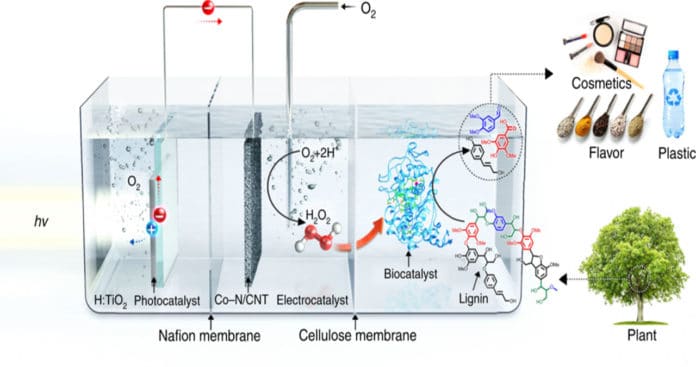Biomass is viewed as a promising replacement for fossil fuels since it is the most abundant carbon source in nature and is carbon neutral. There have been incredible advancements in biomass transformation technologies, particularly the conversion of sugar or starch crops to biofuels and various chemicals.
However, the use of edible biomass as a feedstock is controversial in terms of ethics and cost. Hence, they have recently emerged as promising carbon sources.
Lignin is nature’s most abundant source of aromatic carbon compounds and can be potentially transformed into high-value products. However, because of its complex/irregular chemical structure and currently limited processing technology, more than 99% of lignin is abandoned or burned.
To make lignocellulosic biomass a more compatible renewable carbon source, scientists at UNIST have developed a new biomass conversion technology, i.e., a fusion catalytic system. Through this system, biomass can be converted to higher-value fuels and chemicals. The system turns forestry biomass residues (i.e., sawdust from timber logging) into fuels.
Biocatalysts, such as enzymes, are often involved in lignin degradation. Thus careful quantification of the input material (i.e., hydrogen peroxide) is essential for the activation of catalysts. At present, the process of extracting lignin from biomass is handled via Anthraquinone Process. However, due to high-pressure hydrogen conditions and precious metal catalysts, not suitable for use with enzymes.
Scientists solved this issue by developing a compartmented photo-electro-biochemical system for unassisted, selective, and stable lignin valorization. The main advantage of this system is that it involves three catalytic systems (a photocatalyst for photovoltage generation, an electrocatalyst for H2O2 production, and a biocatalyst for lignin valorization) that are integrated for selective lignin dimer valorization upon irradiation with sunlight without the need for electrical energy or additional chemicals.
To design the system, scientists primarily placed polymer electrolyte membranes as separators between cells to protect the biocatalyst from detrimental conditions generated during the reaction, thus preserved its stability and activity.
Their outcomes show that the photo electro-biochemical framework can catalyze lignin dimer cleavage with a 93.7% transformation proficiency and 98.7% selectivity, which far outperforms those of a single-compartment (37.3% and 34.8%) and two-compartment (25.0%, 48.1%) system.
The system was additionally applied for sustainable polymer synthesis utilizing a lignin monomer, coniferyl liquor, with a 73.3% yield and 98.3% of conversion proficiency; nonetheless, the polymer yields of the single-compartment and the two-compartment systems were just ca. 0% and 8.6%, respectively.
Professor Ji Wook Jang said, “This unassisted selective lignin valorization technology could convert waste lignin to value-added aromatics and polymer without the need for any additional energy and chemicals.”
“This could overcome the problems associated with current biomass up-gradation, such as its low cost-effectiveness and limited processing technology.”
Professor Yong Hwan Kim said, “This research is significant as it presents new possibilities for converting biomass such as waste wood into aromatic petrochemicals in an environmentally friendly way. We believe that the development and scaling-up of this technology will be a milestone for the replacement of petrochemicals with biochemicals.”
The findings of this research have been published in the prestigious Nature Communications on November 12, 2019. The study has been participated by Myohwa Ko (Combined M.S/Ph.D. of Electrical and Computer Engineering, UNIST), Le Thanh Mai Pham (Postdoctoral researcher, UNIST), and Profesor Young Jin Sa (Department of Chemistry, Kwangwoon University).
